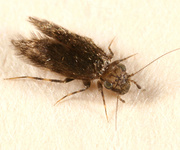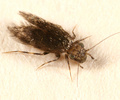Lepidopsocidae
Emilie Bess and Kevin P. Johnson


This tree diagram shows the relationships between several groups of organisms.
The root of the current tree connects the organisms featured in this tree to their containing group and the rest of the Tree of Life. The basal branching point in the tree represents the ancestor of the other groups in the tree. This ancestor diversified over time into several descendent subgroups, which are represented as internal nodes and terminal taxa to the right.

You can click on the root to travel down the Tree of Life all the way to the root of all Life, and you can click on the names of descendent subgroups to travel up the Tree of Life all the way to individual species.
For more information on ToL tree formatting, please see Interpreting the Tree or Classification. To learn more about phylogenetic trees, please visit our Phylogenetic Biology pages.
close boxIntroduction
The family Lepidopsocidae contains 19 genera and about 200 species distributed worldwide. Fifteen species are present in North America, mostly in tropical or subtropical regions.
Lepidopsocids are small-to-medium sized bark lice that are easily recognized by their distinctive pointed wings, triangular head shape, and scaly or hairy body covering. Lepidopsocids can resemble tiny moths. They live on trees, shrubs, and stone outcrops and are occasionally found in stored food products.
Characteristics
Synapomorphy
- Body and forewings are covered with scales or dense hairs. (Note: scales often fall off specimens that are preserved in liquid.)
General Charaters
- Head:
- Head has triangular shape with eyes at the top outer margin.
- Antennae have up to 50 segments.
- Ocelli are far apart.
- Legs: Tarsi have 3 segments.
- Wings:
- Adults may have full-length or reduced wings.
- Wings are usually pointed and often narrow.
- Forewings are covered with dense scales or (less commonly) dense hairs. (Note: scales often fall off specimens that are preserved in liquid.)
- Forewings:
- Veins are nearly parallel to long axis of wing.
- Pterostigma is not thickened.
- Veins CuP and 1A meet wing margin separately (do not form nodulus).
- Hindwing vein M usually has 2 branches.
- Male:
- Paraproct has an anal spine.
- Phallosome is composed of two arms that are never fused anteriorly.
- Female:
- Paraproct has an anal spine.
- Gonapophyses are reduced:
- Dorsal & ventral valves are usually absent.
- External valve is elongate and hairy.
How to Know the Family
- Head has triangular shape with eyes at the top outer margin.
- Wings are usually pointed and often narrow.
- Forewings are covered with dense scales or (less commonly) dense hairs.
- Forewing veins are nearly parallel to long axis of wing.
Discussion of Phylogenetic Relationships
The monophyly of family Lepidopsocidae is supported by the presence of scales or dense hairs covering the body and forewings. Molecular analysis including the five genera of Lepidopsocidae strongly supports monophyly of the family (18S & Histone3 nDNA, 16S rDNA; Yoshizawa et al. 2006).
References
Lienhard, C. and C.N. Smithers. 2002. Psocoptera (Insecta) World Catalogue and Bibliography. Muséum d'Histoire Naturelle, Geneva, Switzerland.
Mockford, E.L. 1993. North American Psocoptera (Insecta). Gainesville, Florida: Sandhill Crane Press.
Smithers, C.N. 1996. Psocoptera. Pp. 1-80, 363-372 (Index) in Wells A. (ed.) Zoological Catalogue of Australia. Vol. 26. Psocoptera, Phthiraptera, Thysanoptera. Melbourne: CSIRO Publishing, Australia.
Smithers, C.N. 1972. The classification and phylogeny of the Psocoptera. Memoirs of the Australian Museum 14: 1–349.
Yoshizawa, K., C. Lienhard, and K.P. Johnson. 2006. Molecular systematics of the suborder Trogiomorpha (Insecta: Psocodea: ‘Psocoptera’). Zoological Journal of the Linnean Society 146: 287–299.
Title Illustrations

| Scientific Name | Echmepteryx hageni |
|---|---|
| Location | Dixville, N.H. |
| Comments | 10/9/2007 |
| Specimen Condition | Live Specimen |
| Life Cycle Stage | adult |
| View | dorsal |
| Copyright | © Tom Murray |
About This Page
Emilie Bess

Illinois Natural History Survey, Champaign, Illinois, USA
Kevin P. Johnson

Illinois Natural History Survey, Champaign, Illinois, USA
Correspondence regarding this page should be directed to Emilie Bess at and Kevin P. Johnson at
Page copyright © 2009 Emilie Bess and Kevin P. Johnson
All Rights Reserved.
- First online 18 March 2009
- Content changed 18 March 2009
Citing this page:
Bess, Emilie and Kevin P. Johnson. 2009. Lepidopsocidae. Version 18 March 2009 (under construction). http://tolweb.org/Lepidopsocidae/30215/2009.03.18 in The Tree of Life Web Project, http://tolweb.org/







 Go to quick links
Go to quick search
Go to navigation for this section of the ToL site
Go to detailed links for the ToL site
Go to quick links
Go to quick search
Go to navigation for this section of the ToL site
Go to detailed links for the ToL site